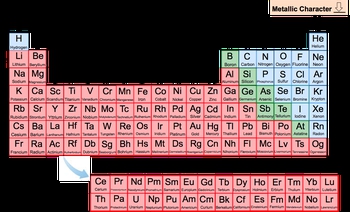Understanding the periodic trends in the periodic table is essential for grasping the metallic characteristics of elements. Periodic trends refer to the predictable patterns observed in the properties of elements as their atomic numbers increase. These trends can be analyzed by moving towards the top right corner of the periodic table, where various properties change systematically.
As we explore these trends, we will focus on key properties such as atomic radius, ionization energy, electronegativity, and metallic character. For instance, atomic radius generally decreases as you move from left to right across a period due to the increasing positive charge in the nucleus, which pulls electrons closer. Conversely, ionization energy, the energy required to remove an electron from an atom, tends to increase in this direction, indicating that atoms become less willing to lose electrons.
Electronegativity, which measures an atom's ability to attract electrons in a bond, also increases towards the top right, highlighting the tendency of nonmetals to attract electrons more strongly than metals. In contrast, metallic character decreases as you move right across a period, with metals being more prevalent on the left side of the table.
By recognizing these trends, students can better understand the behavior of elements and predict their properties based on their position in the periodic table.


